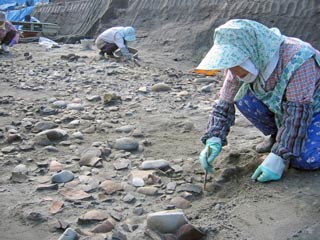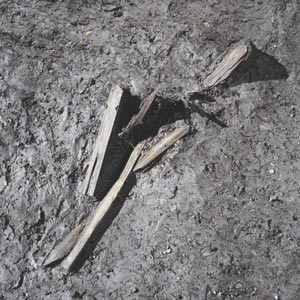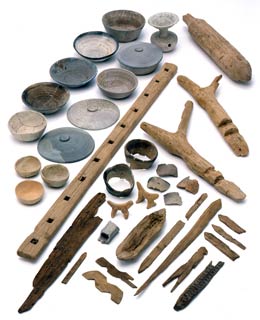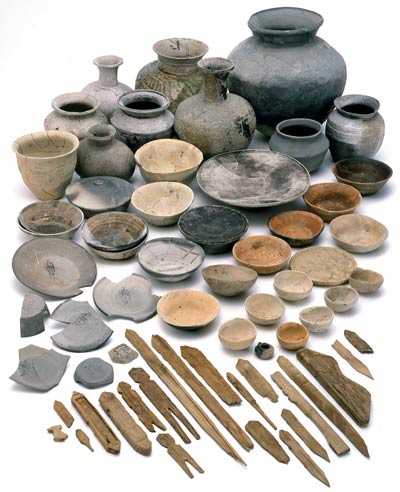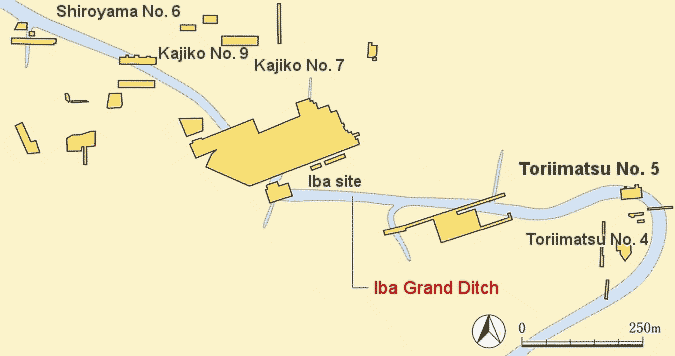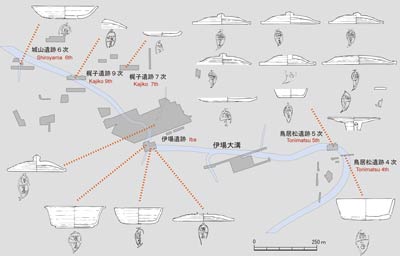Toriimatsu:
Excavation of river
remains extends the range of the Iba ancient government office site eastward. A
Kofun period sword with gold and silver ornamentation is also found.
Toriimatsu Site, Hamamatsu City, Shizuoka Prefecture
Discovery of the “Iba Grand Ditch&rdquo
Toriimatsu is the site of an ancient river flowing from the Iba site, well-known as the remains of an ancient government office. In excavation No. 5 conducted at the site in 2008, the remains of the river coming from Iba (the Iba Grand Ditch) were confirmed. The sites in the area can be regarded as forming the Iba Site Group.
In excavations conducted at Iba from 1969 to 1980, more than 100 mokkan (wooden documents) from the Ancient period were recovered, along with large amounts of items such as ink-inscribed pottery and wooden ritual implements. From such a rich body of documentary materials, rare for outlying regions, it is thought to be the site of the government office of the district of Fuchi in the ancient province of Tōtōmi.
Artifacts related to a government office are found
Numerous artifacts from the Kofun to the Heian periods were recovered in the excavation from within the river that extended 25 m in width and 3 m deep. Noteworthy are items related to a government office of the Nara and Heian periods, such as several tens of ink-inscribed pottery, inkstones, a rich assemblage of wooden ritual implements, and mokkan. These are the same as previous finds from the Iba site, and it has become certain that the Fuchi district office held to have been in the vicinity of the Iba site extended as far as Toriimatsu. The scale of the district office is much larger than previously thought, as it is seen to extend 1.5 km east-west.
An ornamented sword is recovered from the riverbed
A sword of the Late Kofun period (latter part of the sixth century) with a rounded pommel and decorated with silver and gold leaf was recovered from the bottom of the river, to the amazement of participants in the investigation. Nearly all ornamented swords of this period are discovered in tombs as grave goods, and there had been no examples found at the sites of rivers in the manner of the Toriimatsu site. The design on the hilt and the technique of manufacture are without parallel domestically, and it is thought to have been made on the Korean peninsula. It can probably be regarded as the ceremonial act of sinking a luxurious imported item to the river bottom. (Suzuki Kazunao)
(principal artifacts, Toriimatsu Site)

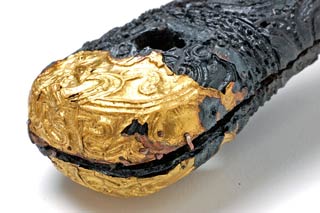 Sword with rounded pommel, ornamented with gold and silver leaf
(photos are of the hilt)
Sword with rounded pommel, ornamented with gold and silver leaf
(photos are of the hilt)Late Kofun period (sixth century).
Length: 79.5 cm;
width: 4.4 cm.
This was made with the process of pressing gold or silver leaf onto a carved wooden base to make the design stand out in relief (gilt bas-relief). The sword was found out of its scabbard. The design is well preserved on the sword's hilt. The end of the hilt (a rounded pommel, upper right) has two dragons depicted on opposite sides of a heart-shaped hole, covered in gold leaf of a high degree of purity. The grip portion of the hilt was carved with a repetitive wave pattern, covered with silver leaf. There are no domestic examples of ornamented swords with these characteristics, and from related materials it is thought to have been made on the Korean peninsula in the first part of the sixth century, and from the pottery of the layer in which it was found, is regarded as having been submerged at the river bottom in the latter part of that century.
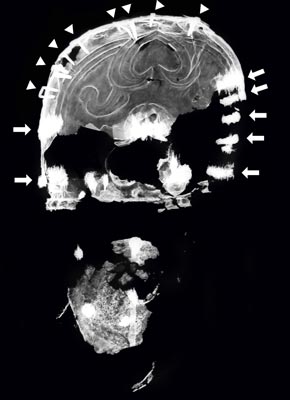
Traces of repair to the pommel (X-ray image) Gold tacks (those with clear outlines, marked in the photo with triangles) and silver tacks (blurred outlines, marked with arrows) were used in differential fashion.

Ornamented sword with rounded pommel in situ
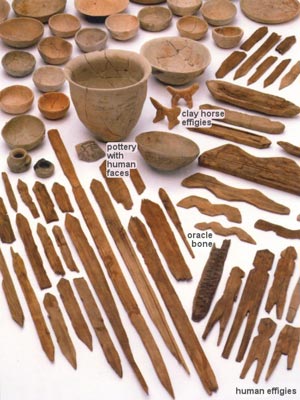 Ritual-related artifacts
Ritual-related artifactsLatter half of the Nara – Early Heian periods (latter half, eighth century – ninth century).
Pot to the left with a human face drawn in ink, height: 13.8 cm.
In addition to wooden ritual implements, large quantities of other items used in ancient rituals were recovered, such as oracle bones, pottery with human faces drawn in ink, and clay horse effigies. Human effigies were found in clusters, and it is inferred they were used in rites conducted by the riverside.

